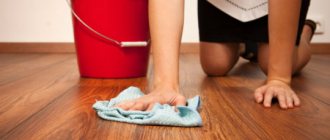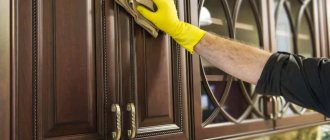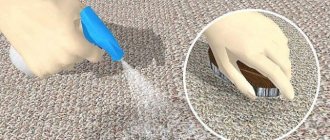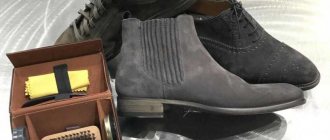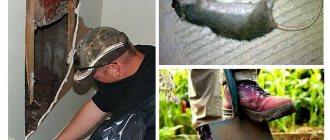Update date: 07/23/2020 11:26:27 10049 Share:
Author: Dina Frish
*Review of the best according to the editors of simplerule.ru. About the selection criteria. This material is subjective in nature, does not constitute advertising and does not serve as a purchase guide. Before purchasing, consultation with a specialist is required.
Dust is an annoying misunderstanding of any interior. It not only creates the feeling of an untidy room, but is also a “breeding ground” for allergens, mites, and often becomes the cause of conjunctivitis, chronic dermatitis and even asthma. How to keep your home clean for a long time? We have collected the most effective and affordable methods for solving the “dust” problem.
Polish "Anti-dust"
Similar products are based on silicone and wax. The most popular of them:
- Furniture polish “Anti-dust” from Pronto. Price: about 200 rubles. Volume: 250 ml. Made on a silicone basis, intended for processing glass, wood, plastic, and household appliances. Directions for use: spray onto a clean, dry surface at a distance of at least 15 cm, then rub with a cloth.
- Furniture polish Chirton “Anti-dust Classic”. Price: about 80 rubles. Volume: 300 ml. The basis of this product is wax. You can care for not only wooden products, but also ceramic, chrome, and plastic. The method of application is similar.
Valuable advice
How to make dry house cleaning more efficient, faster and more enjoyable? It is enough to take into account a few important rules.
Rule #1
.
The fewer items in the room during cleaning, the better.
Large objects must be covered so that dust does not settle on their surface during cleaning. It is better to store all small items in a place isolated from light and air (box, drawer, etc.). Rule #2
. Covers for mattresses and pillows must be hypoallergenic. Any dense natural material is suitable as a cover - it will prevent the spread of dust mites.
Rule #3.
It is better to cover the upper part of the furniture with newspapers or oilcloth. When cleaning a room, it is recommended to cover all the furniture on top with improvised materials to prevent dust particles from settling there.
Rule #4.
Don't forget about light bulbs and lamps. An important cleaning step. All chandeliers are cleaned immediately after removing dust from the ceiling. You can remove dust from the light bulbs only after they have completely cooled down.
Rule #5.
The humidity in the room should be optimal. The relative humidity level for domestic premises at the time of cleaning ranges from 30-50%. A dehumidifier, air conditioner, etc. will help achieve such indicators.
What can be done to prevent dust from accumulating on objects for as long as possible:
- Carry out wet cleaning in the house on a regular basis. This will prevent the constant transfer of dirt and dust from room to room.
- A broom and broom are not suitable for dry cleaning. It is recommended to use microfiber cloths, a damp cotton or wool cloth, and napkins with a fluffy surface.
- To clean the floor, you can use a vacuum cleaner or a damp broom.
- When using a vacuum cleaner, the best option would be aqua filters - they are very effective in fighting dust.
- Regularly remove dust from soft toys, pillows, curtains, textiles, etc.
- Brush your pets regularly. Remove their fur from furniture and carpets using a special roller.
- During the cleaning process, use antistatic agents to prevent the accumulation of dust on objects.
How to clean hard-to-reach places from dust? Books can be cleaned of dust using a vacuum cleaner and a special long-hair attachment. Carefully go over the books with it, and wipe the shelves on which they stand with a damp cloth (let them dry before putting the items back in place). A damp sheet and a carpet beater can help clean dusty upholstered furniture. Place the fabric on the soft upholstery and beat it out thoroughly (all the dust will come out, clinging to the sheet). Then vacuum and steam with an iron to destroy microorganisms. It is enough to repeat the procedure a couple of times a year.
A soft, damp sponge will help remove dust from indoor plants with wide leaves. If the leaves are small, they can be washed under a light shower and placed in the bathroom - both clean and beneficial for plants.
Cleaning wallpaper is also important, because dust settles on it too. First you need to lightly vacuum, then wipe with a damp cloth (if the material allows wet cleaning). Blinds should be washed directly on the window, after placing them in the closed position. A special brush or one of the available tools listed below will do. If the contamination is too strong, you will have to remove the blinds.
How to secure furniture?
In order to avoid spending most of your life cleaning, you need to prevent dust from settling on horizontal surfaces. Then you can wipe them less often. Here's what you can do for this:
- It is advisable to use all of the listed antistatic agents only after complete wet cleaning, otherwise dirt will be transferred from one object to another, and all efforts will be pointless.
- Maintain a humidity level in the room of at least 40% so that dust molecules do not constantly fly around in dry air, but immediately settle down and can be wiped off.
- Air purifiers will also help remove airborne dust elements and germs.
- Store books and small decorative items on glass shelves - much less dust gets in there.
- Use special organizers, trunks and cases to store clothes and bedding that you don’t use every day.
- Never apply polish, wax or similar products directly to the surface of furniture, otherwise a sticky film will form on it, which will attract even more dust. You need to treat furniture with a cloth or a special sponge.
- Replace filters in vacuum cleaners and air purifiers in a timely manner, otherwise they will no longer perform their function.
- Do not leave windows open for long periods of time. It is certainly necessary to ventilate the premises, but it is better to allocate special time for this, opening the windows wide and creating a draft. If the windows are constantly fixed in micro-ventilation mode, then you will not be able to get rid of dust for a long time.
Video: how to clean a house in an hour?
Cleaning process
Thorough dust removal is a painstaking process, but not difficult if done correctly.
Step one
. Remove the maximum number of objects from the room (if possible), having first cleared them of dust (this could be a clock, carpet, table lamps, etc.). This will simplify the process of cleaning hard-to-reach places - you will not need to constantly move objects around the room.
Step two.
Select the appropriate tool, cleaning product and begin the process. You need to start with the objects and places that are highest. In addition, it is important to choose a certain direction when moving around the room (clockwise or counterclockwise) and strictly adhere to it. This will help to efficiently remove all the dust without missing a single area of the room. Tools used for cleaning should only be cleaned outside the room.
Don't forget about hard-to-reach places - the top of cabinets, the floor area under the bed, cornices, the place behind the TV, etc. If you need to clean areas behind large furniture that cannot be moved, you can use a thin, clean brush. To remove cobwebs from the ceiling, use a damp brush or a rag placed over a mop.
Step three
. Cleaning floors and furniture is the last and no less important stage of cleaning. First - furniture. It is better to clean fabric ones with a vacuum cleaner, and wooden ones with a soft damp cloth without using detergents. When using a damp cloth, you need to act smoothly, moving it from one part of the product to another, gradually bending the contaminated area until the fabric turns into a lump. After that, take a new rag. Now you can start working on the floors. If there are large carpets that could not be removed, you need to clean them with a vacuum cleaner. It is enough to walk over the floor covering with a damp cloth mop.
How to properly wipe off dust? It would seem that this is not so difficult. But only at first glance. If done incorrectly, dust particles will immediately settle back onto all objects in the room. You need to start with the ceiling: if the material allows, carefully walk over its surface with a damp cloth or broom. Do not forget about the corners (this is where most of the dust often accumulates).
Further
– cleaning ceiling lights (you can use wet wipes). Next come the cabinets and window sills (movements should be strictly from top to bottom). Then all other items. Particular care must be taken to treat electrical appliances that are known to be prone to dust accumulation (in this case, moisture is unacceptable).
Sprays
Special sprays are used to treat furniture, carpets, mattresses and various textiles. They neutralize allergens from dust mites, pets, plants, and also remove static electricity. Such products are more aggressive and are not designed for use with every wet cleaning. They can be sprayed no more often than once every six months. People suffering from allergies and asthma should especially pay attention to such sprays.
Before using the spray, the surface is cleaned of dust and dirt, and then the product is evenly distributed and allowed to dry (about 20-30 minutes). You should first check the item for paint fastness. To do this, apply the spray to an inconspicuous area. This treatment is not suitable for varnished parts.
The Best Tools for Effective Dust Removal
Not every item is suitable for dust collection. The following are the most effective, convenient and affordable options.
Fabric gloves
A practical tool for cleaning any piece of furniture. The product is equally suitable for both light and dark surfaces.
Sock
A budget solution for getting rid of a layer of dust. Used as an alternative to fabric gloves. It is enough to put a sock made of natural fabric on your hand and walk over objects contaminated with dust. And by putting a sock on the mop, you can easily reach remote dusty places like the top of a cabinet or the space between the cabinet and the wall.
Soft brushes
A practical and convenient tool for cleaning dust from hard-to-reach places (for example, a computer keyboard or a relief vase). If you use a soft brush regularly, it should be changed at least once a month.
Wet wipes
Trite? Not at all. After all, we are not talking about classic wet wipes, which will simply clump up the dust. You don't often find special wipes in stores, but they are very effective. The product is only suitable for wooden surfaces (it will leave unsightly stains on all others).
Paper towel roll
A vacuum cleaner is certainly a useful and effective household appliance, but sometimes it is impossible to reach certain places with it. A paper towel roll can be used as a handy attachment to easily remove dust from blinds, cabinet rails, etc.
Microfiber
An old proven way to remove dust in the house. A cloth made of microfiber quickly and thoroughly collects all dust particles, and in combination with an effective dust removal composition will allow for high-quality dry cleaning.
Alcohol
Sometimes a dense layer of dust accumulates on the glass, making it quite difficult to remove it using available means (and sometimes even glass cleaning fluid). But for alcohol this is not a problem at all. You can use medical alcohol or vodka. Moisten a cotton pad or cotton swab in the chosen product and carefully walk over the glass. If the area is large, you can pour the alcohol into a spray bottle and the cleaning will move to a new level.
Roller for clothes
A worthy alternative to a damp cloth or antistatic spray. A convenient tool for cleaning dust from upholstered furniture - any upholstery. Using a clothes roller, you need to make sequential movements, gradually moving from top to bottom. Do not forget to periodically remove the dirty tape.
Attention! This material is subjective in nature, does not constitute advertising and does not serve as a purchase guide. Before purchasing, consultation with a specialist is required.
Best Dust Removers
Special formulations
Store shelves today are literally overflowing with all sorts of products designed to remove dust. This means choosing the right one must be approached with special care. To simplify the task, you need to take into account the type of household chemicals. Conventionally, it can be divided into several types:
- Polishes are an ideal option for quick wet cleaning. Special components in such products create a special protective layer on the surface, which makes objects more resistant to dust: the surface is protected from the settling of dust particles for 2-3 days.
- Antistatic agents - such compounds are best used for cleaning electrical appliances and household appliances. Antistatic agents perfectly remove even an impressive layer of dust from TVs, computers, music speakers, etc. In addition, such products can easily cope not only with dust, but with fingerprints and non-chemical stains. To increase the efficiency of cleaning using antistatic agents, it is recommended to use special wipes for household appliances.
- Impregnations are products designed to remove dust particles from upholstered furniture. To obtain maximum effect, manufacturers recommend using such compositions at least 3-4 times a month.
- Sprays not only effectively deal with dust settling on objects, but also fight allergens and dust mites. The sprays contain special components that prevent dust from settling for a long time.
Homemade antistatic agents
If you don’t have a store-bought anti-dust product in your home, you can prepare an effective composition from available ingredients or use alternative ready-made compositions:
- Lemon solution will easily cope with dust and will not leave any streaks. Cut a medium lemon into slices, place in a deep narrow container and add 7 tbsp. spoons of vegetable oil. Leave for a week. Then add a glass of boiling water to the infused mixture and strain. Dip a clean cloth into the cooled solution, wring it out and dry thoroughly. After this, it can be used to effectively remove dust from any surface.
- Essential oils are some of the best antistatic agents (especially lavender and rose oils). It is enough to add a few drops of any of these oils to the water for cleaning. Use the resulting mixture to wipe dusty objects using a cotton or wool cloth.
- Vinegar solution is an excellent antistatic agent - a worthy alternative to store-bought products. If desired, it can be prepared without much difficulty. To do this you will need vinegar (30 ml), olive oil (2 tablespoons), purified water (100 ml) and eucalyptus essential oil (10 drops). It is recommended to use the prepared composition in a spray bottle - this will help to evenly distribute the product over the surface.
- Laundry softener - fabric softener is great for other household needs. It can be an excellent alternative to ready-made antistatic agents. Making an effective solution is very simple: dissolve 20 ml of any fabric softener in 1 liter of water. Dampen a clean cloth with it and carefully walk it over the dust-contaminated surface.
- Bleach is another great antistatic agent for hard surfaces. Mix purified water and bleach in equal proportions. Use the resulting composition to remove dry dust.
- Glycerin solution - suitable for cleaning decorative and polished surfaces. Mix glycerin with purified water in a ratio of 1:10 and feel free to use the resulting solution to wipe dust off any hard products.

